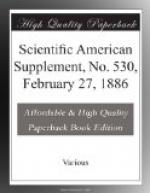The conditions under this head
are:
1. Absence of steam.
2. Absence of smoke and cinders.
3. Absence, more or less complete, of noise.
4. Elegance of aspect.
5. The facility with which the motor can
be separated
from the carriage itself.
6. Capacity of the brake for acting upon
the greatest
possible number of wheels of the vehicle
or vehicles.
7. The degree to which the outside covering
of the
motor conceals the machinery from the public,
while
allowing it to be visible and accessible
in all parts to
the engineer.
8. Facility of communication between the
engineer
and the conductor of the train.
In deciding upon the relative merits of the several motors, so far as the eight points included under this heading are concerned, it is clear that, except possibly as regards absence of noise, the electrical car surpassed all the others.
The compressed air car followed, in its superiority in respect of the first three points, viz., absence of steam, absence of smoke, and absence of noise; but the Rowan was considered superior in respect of the other points included in this class.
Under the letter B have been classed considerations of maintenance and construction.
9. Protection, more
or less complete, of the machinery against the
action
of dust and mud.
10. Regularity and smoothness
of motion.
11. Capacity for passing over
curves of small radius.
12. The simplest and most
rational construction.
13. Facility for inspecting
and cleaning the interior of the boilers.
14. Dead weight of the train
compared with the number of places.
15. Effective power of traction
when the carriages are completely full.
16. Rapidity with which the
motor can be taken out of the shed and
made
ready for running.
17. The longest daily service
without stops other than those
compatible
with the requirements of the service.
18. Cost of maintenance per
kilometer. (It was assumed, for the
purposes
of this sub-heading, that the motor or carriage which
gave
the best results under the conditions relating to
paragraphs
9, 10, 12, and 13 would be least costly for repairs.)
As regards the first of these, viz., protection of the machinery against dirt, the machinery of the electrical car had no protection. It was not found in the experiments at Antwerp that inconvenience resulted from this; but it is a question whether in very dusty localities, and especially in a locality where there is metallic dust, the absence of protection might not entail serious difficulties, and even cause the destruction of parts of the machinery.
In respect to the smoothness of motion and facility of passing curves, the cars did not present vary material differences, except that the cars in which the motor formed part of the car had the preference.




